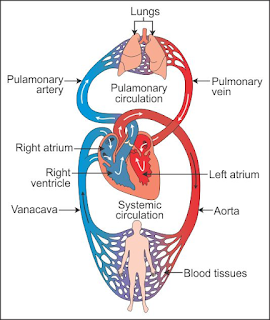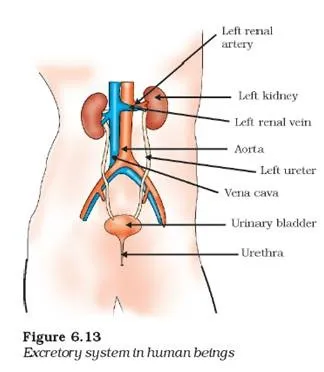CBSE Class 10 Science Notes Chapter 6 Life Processes - CBSE HUB ONLINE
Life
Processes:
Various functions that are carried out by living as which are necessary to maintain and continue life are called processes. Life processes in living beings include nutrition, respiration, transportation of substances and excretion.
Nutrition: It is the process of intake of nutrients from outside to the inside of the body of living organisms, providing energy necessary to grow, develop and prevent damage.
Types of Nutrition: There are two types of nutrition:
1.Autotrophic nutrition
2. Heterotrophic nutrition
Autotrophic Nutrition: It is the mode of nutrition performed by green plants, some bacteria, etc., for manufacturing their own food from inorganic sources, i.e., CO2 and water. These organisms are
called autotrophs.
Photosynthesis: It is the process by which green plants synthesize organic food as carbohydrates from carbon dioxide and water in the presence of sunlight and chlorophyll.
Photosynthesis occurs in three stages, i.e.,,
i) absorption of light energy by chlorophyll .
ii) conversion of light into chemical energy and splitting of water molecules into hydrogen,and, oxygen and
iii) reduction of carbon dioxide to carbohydrates,
The whole process can be shown by the following equation:
internal energy reserve and is used whenever required by the plant.
Chloroplasts: They are the site of photosynthesis and
are present in leaves of a plant. They contain a green coloured pigment called
chlorophyll that traps solar energy from Sun.
Stomata: These are tiny pores present on the
surface of the leaves. Massive amount of gaseous exchange for the purpose of
photosynthesis and transpiration takes place through stomata. The opening and
closing of stomata is a function of the guard cells.
Heterotrophic
Nutrition: The mode of
nutrition in which an organism takes food from another organism. Heterotrophs
cannot synthesize their own food but are dependent on autotrophs for their
nutrition. It can be divided into three types as follows:
(i)
Saprotrophic
Nutrition: It is the
mode where nutrition is derived from the breakdown of complex molecules
in dead and decaying organic matter. e.g., Bacteria, fungi such as
mushroom etc.
(ii)
Holozoic Nutrition: It is the mode of nutrition where
complex molecules are taken in and broken into simpler forms, e.g.,
Amoeba, cow, goat, humans, etc.
(iii) Parasitic Nutrition: In this mode, the organisms derive nutrition from the host's body they live on or inside,e.g., ticks, lice, leech, Cuscuta
(Amarbel) in plants etc.
Nutrition in Amoeba: Amoeba is a unicellular animal which
follows holozoic mode of nutrition. It lacks special organs for nutrition. It
takes in food using pseudopodia (Finger-like extensions) which fuse over
the food particle forming a food vacuole. Inside the food vacuole, complex
substances are broken down into simpler ones which then diffuse into the
cytoplasm. The remaining undigested food is moved to the surface of the cell
and is then thrown out.
It involves breakdown of complex substances ingested from outside by different parts of alimentary canal.
Human Digestive System: It consists of alimentary canal, i.e., a tube-like structure consisting of mouth, pharynx, oesophagus, stomach, small intestine and large intestine.
Digestive Glands:
These include salivary, gastric, intestinal glands along with pancreas and
liver.
Salivary Glands (in
mouth): These secrete
saliva containing salivary amylase which helps in breakdown of starch into
simple sugar.
Gastric Glands: These are present in the wall of the
stomach and releases pepsin, HCl and mucus.
Liver: It is the largest gland of our body
that secretes bile juice for emulsification of fats, which is stored in gall
bladder.
Pancreas: It secretes pancreatic juice containing
trypsin, for digesting proteins and lipase for breaking down emulsified fats.
Intestinal Glands: These are present in walls of small
intestine and secrete intestinal juice. The enzymes present in it finally
convert the proteins to amino acids, complex carbohydrates into glucose and
fats into fatty acids and glycerol.
Role of Villi:
(i) They
increases the surface area for absorption of food.
(ii) They are
richly supplied with blood vessels which takes the absorbed food to each
and every cell of the body, where it is utilised for obtaining energy, building
up new tissues and the repair of old tissues.
Respiration:
The process by which food (glucose) is broken down provide energy in the form
of ATP (Adenosine Triphosphate).
Types of
Respiration:-
Respiration
is of two types:
Aerobic respiration
Anaerobic respiration.
Aerobic Respiration: It is complete breakdown of food
occurring the presence of oxygen. It releases large amount of energy, as
ATP.
Anaerobic
Respiration: It is
incomplete breakdown of food occurring in the absence of oxygen,
releasing small amount of energy. It can be alcoholic fermentation, i.e.,
glucose breaks into ethanol and CO2 or lactic acid fermentation,
i.e., glucose breaks into lactic acid.
Respiration in
Animals: It may occur
through their skin or through specific respiratory organs. These organs have
structures that increase the surface area which is in contact with the oxygen
rich atmosphere.
Respiration in
Aquatic Organisms: Fish
and other aquatic organisms use gills to take up oxygen dissolved in water.
Fish
exchange gases by pulling oxygen rich water through their mouths and pumping it
over their gills, where the dissolved oxygen is taken up by blood
flowing in blood vessels.
The rate of breathing in aquatic organisms is
much faster than in terrestrial organisms because the amount of
dissolved oxygen is Fairly low as compared to the amount of oxygen in air.
Respiration in
Terrestrial Organisms:
These organisms use atmospheric oxygen for respiration. Respiration in Human
Beings: It involves inhalation and exhalation, i.e., taking air (oxygen) into
the lungs and giving out air (carbon dioxide) from the lungs.
► Human Respiratory System: It consists of nostrils, pharynx, larynx,trachea, bronchi and bronchioles, alveoli and the lungs.
Lungs: These are the primary organs for respiration, present in the thoracic cavity.In lungs, millions of balloon-like structures called alveoli are present, which have a rich supply of blood vessels and help in exchange of gases.
Ribs: These are 12 pairs of bones, which help
in respiration by movement of intercostal muscles attached to them.
Diaphragm: It is a muscular partition between
thorax and abdomen. : It Forms the base of chest cavity and helps in breathing.
Gaseous Exchange in
Humans: The blood
brings carbon dioxide from the rest of the body for release into the alveoli
and the oxygen in the alveolar air is taken up by blood in the alveolar blood
vessels to be transported to all the cells in the body.
Haemoglobin: It is the respiratory pigment present in
Red Blood Cells (RBCS) which takes up the oxygen from the air in lungs and
carries it to different tissues.
Transportation in Animals: The life process facilitating the movement of Food, water and oxygen from one part of the body to other via circulatory system.
Blood: It is a specialised connective tissue consisting of plasma and formed elements (i.e., RBC, WBC and platelets). It helps in transport of nutrients, gases, waste products, etc. and regulates body temperature and pH, etc.
Types of Blood
vessels:
(i) Arteries: They carry oxygenated blood from the heart to various organs of the body. They have thick, elastic walls.
(ii) Veins: They collect deoxygenated blood from various organs and bring it back to the heart. They have thin walls and valves.
(iii) Capillaries: These are the smallest vessels which
help in exchange of material between the blood and surrounding cells.
Blood Circulation: In humans, double circulation occurs,
i.e., blood passes through the heart twice in one cycle. It has two components:
(i) Systemic Circulation: The pathway of blood from the heart to the rest of the body and back to the heart.
(ii) Pulmonary Circulation: The pathway of blood from the heart to the lungs and back to the heart.
Lymph: It is similar to plasma but colourless
with less proteins, it carries digested and absorbed fat from intestine
and drains back excess Fluid into the blood.
Blood Circulation
through Heart: Lungs → Pulmonary
vein (Oxygenated blood) → Left atrium
left ventricle Main artery (Aorta) → Body organs → Main vein (Vena cava) → Right atrium → Right ventricle → Pulmonary artery (Deoxygenated blood) → Lungs
Plants have specialised tissue transportation of substances. There are two types of tissues in plants:
1. Xylem :- It transports water and minerals obtained from the composed
of tracheids, xylem vessels, Xylem parenchyma and Xylem Fibre.
2. Phloem:-
it transports products of photosynthesis from the leaves to other parts
of plant, i.e., translocation. It is composed of sieve tubes, companion
cells, phloem parenchyma and phloem fibres.
Transport of Water: It occurs due to transpiration pull and
root pressure.
Transpiration: It is the loss of water vapour from
aerial parts of plant i.e., stomata and lenticels. The pressure exerted by
transpiration on the walls of xylem is called transpiration pull causing upward
movement of water and minerals. It also helps in temperature regulation.
Transport of Food: The transport of soluble products of
photosynthesis from the leaves to other parts of plant is called translocation.
It is a form of active transport and flow of substances takes place in
both directions i.e., it is a two-way traffic in phloem.
The
phloem also transports amino acids and other substances to the storage organs
of roots, fruits and seeds and to growing organs.
Excretion in
Animals: It is a
biological process for the removal of harmful metabolic wastes from the body.
In unicellular organisms, wastes are excreted
via diffusion while multicellular organisms have specialised organs for
excretion.
Human Excretory
System: It removes
nitrogenous waste products From the body. It includes a pair of kidneys, a pair
of ureters, a urinary bladder and a urethra. The nephron is the basic
structural and functional unit of the kidney.
Formation of urine occurs to filter out waste products
from the blood. It involves three stages i.e., ultrafiltration in glomerulus,
selective reabsorption of useful substances such as glucose, amino acids, etc.,
in tubular part and tubular secretion, i.e., active secretion ions, medicines,
drugs, etc., from blood into urine.
Urine:- It is the end product artery formed that contains urea, uric acid,ammonium salts and urochrome pigment Aorta imparts yellow colour to urine.
Removal of Urine: Urine Urinary bladder remains stored in the - Urethra urinary bladder until the pressure expands too much. We can control the urge to urinate.
Kidney disorders occur when one or both kidneys stop functioning or malfunctions.
Excretion in Plants: It occurs to remove the wastes
excreted by them during their life processes. Gaseous waste products are carbon
dioxide during respiration and oxygen during photosynthesis which are excreted
out through stomata and lenticels.
Liquid waste products are excess water, gums i.e., degradation product of internal tissues, resins, etc. which are excreted by transpiration via stomata (guttation).
Solid waste products are stored waste substances in cell
vacuoles and tissues with dead cell. These wastes are removed by dropping of
leaves, peeling of bark and felling of fruits.
Some
of the plant wastes are useful products for human beings, e.g., essential oils,
gums (used to make adhesives), resins, natural rubber (tyre industry) and
tannin (for leather treatment), etc.
Chapter 1 Chemical Reactions and Equations - Notes
Chapter 2 Acids,Bases and Salts - Notes
Chapter 3 Metals and Non-metals -Notes
Chapter 4 Carbon and Its Compounds -Notes
Chapter 5 Periodic Classification of Elements -Notes
Chapterwise Notes for Class 10 Science Physics
Chapter 10 Light Reflection and Refraction -Notes
Chapter 11 Human Eye and Colourful World -Notes
Chapter 13 Magnetic Effects of Electric Current -Notes
Chapter 14 Sources of Energy -Notes
Chapterwise Notes for Class 10 Science Biology
Chapter 6 Life Processes -Notes
Chapter 7 Control and Coordination -Notes
Chapter 8 How do Organisms Reproduce? -Notes
Chapter 9 Heredity and Evolution -Notes
Chapter 15 Our Environment -Notes
Chapter 16 Management of Natural Resources -Notes
We hope the given -Notes for Class 10 Science will help you. If you have any query drop a comment below and we will get back to you at the earliest.












0 Comments
Please don't give write any spam link.